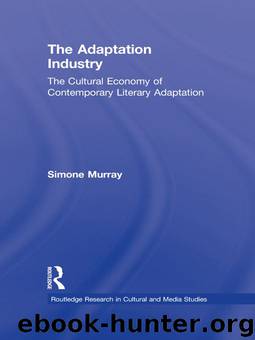The Adaptation Industry: The Cultural Economy of Contemporary Literary Adaptation (Routledge Research in Cultural and Media Studies) by Simone Murray

Author:Simone Murray [Murray, Simone]
Language: eng
Format: epub
Publisher: Taylor and Francis
Published: 2012-03-11T23:00:00+00:00
© Anthony Minghella and Michael Ondaatje, The English Patient: A Screenplay, Methuen Drama, an imprint of A&C Black Publishers Ltd
One benefit of Bourdieu’s productive concept of the cultural ‘field’ is that it rejects simplistic centre–periphery models of influence (such as the metaphor of ripples emanating from a cast stone employed above) and permits us to see how, in the complexly interdependent structure of the field, changing a single element triggers myriad other changes amongst existing agents. With this in mind, it is possible to understand not only how the Booker influences screen media by driving adaptation traffic, but how those same adaptations generate a powerful feedback effect for the book industry. Just as the Booker film aims to transmute literary critical esteem into an audio-visual vocabulary, so too the book industry eagerly appropriates to itself a film adaptation’s critical plaudits. Witness the strategic release of film tie-in editions, published screenplays, spin-off and companion titles (explored in detail in the following chapter). For example, even prior to the Academy Award success of Minghella’s film The English Patient, the drip-feed of festival buzz and laudatory early reviews ensured that tie-in editions of the book began appearing in bestseller lists in multiple publishing territories. Furthermore, Minghella’s screenplay (1997), itself packaged with a tie-in cover design utilising the film’s poster art, achieved significant profile (Korte and Schneider, 2000: 94). Most astounding of all, a companion-themed edition of Tales from Herodotus (1997) (an important intertext in both the novel and film) was released by the usually sedate Penguin Classics imprint with the strapline ‘As featured in The English Patient’ reproduced at the same size as the book’s title on its front cover. This unlikely publishing package also proceeded to mount the bestseller lists, partly on account of it being displayed at point of sale in bookshops along with gift-book and ‘novelty’ non-book items. Writing in direct response to these phenomena, an again rather curmudgeonly Robert McCrum lamented at the time that ‘film and fiction are becoming so interbred that it will soon be meaningless to fuss over the distinction to be drawn between a new script and a new novel’ (1997: 15) – an observation highly reminiscent of the ‘twin-track’ approach to contemporary authorship explored in Chapter 1. But our response to this phenomenon need not be so testy. The general public’s familiarity with, and appetite for, Booker titles is increasingly mediated via film and TV adaptations. Even the Booker Prize has come to define itself publicly as in part a content incubator for esteemed screen adaptations. Such accelerating twenty-first-century developments highlight the fact that there is no longer a discernible ‘literary’ ecosystem, only a literary sphere of an encompassing media system (Korte and Schneider, 2000: 105). McCrum is correct to the extent that, in an era characterised by avid adaptation, impermeable boundaries between media can – and need – no longer be drawn.
Download
This site does not store any files on its server. We only index and link to content provided by other sites. Please contact the content providers to delete copyright contents if any and email us, we'll remove relevant links or contents immediately.
Call Me by Your Name by André Aciman(20351)
Ready Player One by Cline Ernest(14497)
How to Be a Bawse: A Guide to Conquering Life by Lilly Singh(7364)
Wiseguy by Nicholas Pileggi(5650)
The Kite Runner by Khaled Hosseini(5062)
On Writing A Memoir of the Craft by Stephen King(4847)
Audition by Ryu Murakami(4822)
The Crown by Robert Lacey(4710)
Call me by your name by Andre Aciman(4600)
Gerald's Game by Stephen King(4556)
Harry Potter and the Cursed Child: The Journey by Harry Potter Theatrical Productions(4429)
Dialogue by Robert McKee(4306)
The Perils of Being Moderately Famous by Soha Ali Khan(4156)
Dynamic Alignment Through Imagery by Eric Franklin(4100)
Apollo 8 by Jeffrey Kluger(3621)
Seriously... I'm Kidding by Ellen DeGeneres(3564)
The Inner Game of Tennis by W. Timothy Gallwey(3558)
How to be Champion: My Autobiography by Sarah Millican(3544)
Darker by E L James(3463)
